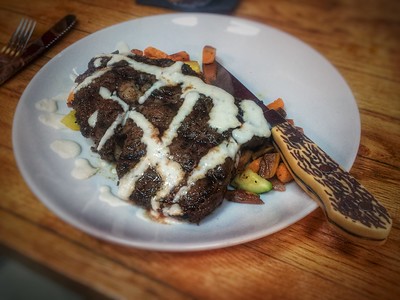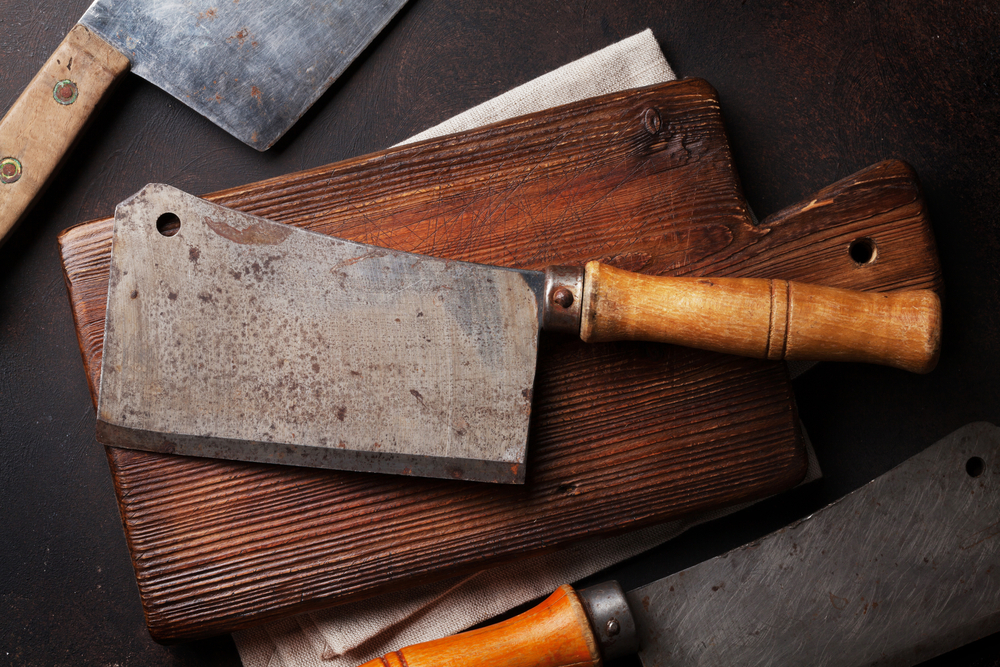Kitchen knives that go unused for a long time or are left in a humid dishwasher can often develop rust, even stainless steel knives. Rusty knives can be dangerous, and they are certainly unsafe for use in food preparation. So before you toss out your rusty knife, we recommend you try cleaning it first, and you may be surprised at how easy it can be.
Fortunately, we’re here to present several ways you can do to prevent rust and even remove it from your knife to make it appear brand new. This article will teach you how to remove rust from steak knives and other types of knife blades using five easy and natural rust removal methods.
Before You Begin: Rusty Steak Knives Explained
What Is Rust, and Why Does It Occur?
Iron oxide, more commonly referred to as rust, is caused by the oxidation of iron. The oxidation process happens when metal is exposed to water and oxygen or extremely humid air for an extended period. Moisture and oxygen react to form a reddish-orange flaky substance, something you certainly don’t want in your food.
Why Do Steak Knives Rust?

Stainless knives and thin metal blades can often naturally rust when left unused for a considerable amount of time. Steak knives can also easily rust in the dishwasher, where it is humid and wet.
In general, rust happens more quickly on non-stainless steel blades, like carbon steel blades, but it can also happen to stainless steel knives. Stainless doesn’t mean stain-proof, but it is more stain resistant.
What Cleaning Supplies Will You Need to Remove Rust on Kitchen Knives?
You can try several easy methods below to remove rust stains on knife blades. Luckily for you, chances are pretty good that you have some or all of the supplies you need in your kitchen already.
Choose one of these main cleaning solution ingredients:
- Baking soda
- White vinegar
- Lemon juice
- Potatoes or onions
- WD-40
Pair your cleaning agent of choice with the following supplies:
- Water
- Dish soap
- Toothbrush (for light rust stains)
- Slightly abrasive sponge (for particularly rusty blades)
- Soft cloth
- Pan, jar, or tall cup (big enough to submerge the knife)
Pro Tip: Some people like to use steel wool, very fine sandpaper, or crumpled aluminium foil as a tool for removing rust spots on kitchen knives, but these materials can often damage the blade on stainless steel and carbon steel knives, so we recommend using a sponge instead.
It may be worth trying steel wool with extremely rusty blades, but be careful and take your time if you decide to use something more abrasive.
Steak Knife Blade Rust Removal: 5 Easy Methods
Method 1: Baking Soda Scrub
The baking soda method is a quick and effective method that is ideal for removing minimal to excessive amounts of rust.
- Clean your kitchen knife or steak knife: To start, ensure you remove any food particles from the blade. Wipe off your blade with a cloth and a small cleaning solution. Avoid using water because it is what caused the rust in the first place.
- Create baking soda paste: Once your knife is clean, mix baking soda and water in a small bowl until it creates a thick paste. An excessive baking powder will make it hard to spread, but you can always add a bit more water if needed.
- Spread the paste over the blade: Next, apply a generous coating of your baking soda paste over the entire knife blade. Cover both sides and any visible rust.
- Scrub the knife rust away: If the knife blade only has a small amount of rust, you can probably scrub it away using a toothbrush. For more built up, try using a moderately abrasive sponge to get rid of rust. However, it would help if you were careful not to scratch the blade. We recommend starting with the sponge and switching to a toothbrush when the rust becomes thinner.
- Wipe the blade clean: When all traces of rust have been removed, wipe your blade clean with a soft cloth. If needed, finish up by washing with a small amount of dish soap and water to remove all traces of the baking soda. Just make sure you dry it thoroughly when you are done.
Method 2: White Vinegar Soak
A substance called acetic acid in white vinegar is an effective tool for removing rust. The acetic acid breaks down the rust spots leaving you with a sharp and safe blade.
- Add white vinegar to your container of choice: Fill a jar, tall cup, or shallow pan with white vinegar. It doesn’t matter which one you choose, so long as you can fully submerge your rusty knife. Also, only use white vinegar. Other types of vinegar can leave stains on the blades, essentially defeating the purpose of cleaning them in the first place.
- Let the blade soak for 5 minutes: Put your knife in the container and let the rusty knife blade soak for up to 5 minutes. Soaking it any longer could damage your blade, so set yourself a timer so you don’t forget.
- Wipe the blade clean: Remove your knife from the vinegar bath and clean it with a soft cloth. If a small amount of rust remains on the blade, we recommend you try the baking soda method to complete the rust removal process.
Method 3: Lemon Juice Soak
Like white vinegar, lemon juice is also acidic enough to be an effective tool for removing rust. You can either squeeze lemon juice or use store-bought lemon juice for this method.
- Create your cleaning solution: Mix equal parts of water and lemon juice in a tall cup. Again, make sure you will be able to submerge your rusty knife blade completely.
- Soak for 10 minutes: Place your knife in the cup and let the blade soak for 10 minutes. Set a timer to avoid oversoaking, as the acidic acid can damage the blade if left on the surface for too long.
- Wipe and scrub the rust away: Extract your knife from the lemon juice solution and wipe it with a soft cloth. You can also gently scrub it with a toothbrush or slightly abrasive sponge. To finish up, rinse the knife clean and dry it thoroughly.
Method 4: Potatoes
Potatoes contain something called oxalic acid, which dissolves rust stains. Oxalic acid is often found in common household cleaning products, so while it may not seem very common sense, the potato method is quite effective.
- Insert the rusty knife blade into a potato: Stick your knife’s blade into a potato and leave it to sit for a few hours.
- Wipe clean: After some time has passed, remove the blade and wipe all rust away. Finish up by giving it a light wash and completely drying the blade.
Method 5: Onions
In much the same way, onions contain sulphonic acid, which is also effective at removing rust on knife blades. However, the onion method is somewhat quicker than the potato method.
- Saw into an onion with the rusty blade: Start sawing back and forth an onion with your rusty knife blade. The rust will start to flake off at surprising speeds.
- Rinse and wipe clean: When all of the rust is gone, finish by wiping it down and washing it as normal. Of course, thoroughly dry it before putting it away.
Pro Tip: After completing any one of the above methods for cleaning a rusted knife, we recommend you take a moment to apply a small amount of mineral oil afterwards.
Mineral oil, or a plant-based substitute like coconut oil, will lubricate the blade, improve the knife’s quality overall, and also help to prevent rust from developing in the future. This can be done with a pocket knife, kitchen knife, or just about knife blade.
Say Goodbye to Your Rusty Blades for Good
Now that you know what rust is and what causes it to form, you may be able to execute some rust prevention. However, you now know how to remove rust from kitchen knives when this isn’t possible.
So, before you toss your rust-covered knife in the bin, try one of our easy methods to clean rust. The chances are pretty good you will be able to avoid buying a new knife, at least for now. Which method do you think you will try first?
Let us know what you think in the comments below.

